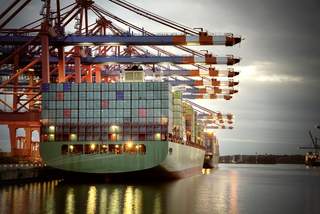
© Fotolia/Robert Mandel
Lose-Lose for Everyone: Trade Wars Have no Winners
U.S. President Donald Trump calls himself “Tariff Man”. Since he took office, the United States has imposed many special duties, including tariffs on steel and aluminium under the guise of national security (Section 232 tariffs). In addition, the number of anti-dumping and countervailing measures – such as tariffs on washing machines and solar cells – has significantly increased. Many countries affected have imposed retaliatory tariffs. In addition, the President has threatened to impose tariffs on cars and car parts.
Since mid-2018, the United States and China are engaged in a serious trade conflict. According to the Peterson Institute, tariffs now affect two-thirds of U.S. goods exported to China and soon almost all Chinese merchandise exports to the United States. Once all announced tariffs come into force on 15 December 2019, the average U.S. tariff on Chinese goods will have risen from three percent at the end of 2017 to almost 24 percent. The average Chinese tariff on U.S. goods will be more than 25 percent; in late 2017, it was only eight percent.
Less Growth in the United States and China
According to the OECD's Economic Outlook of September 2019, the United States and China account for the largest share of worldwide economic losses. The additional tariffs between the two economic superpowers will cost the United States 0.7 percentage points of GDP in 2021 and 2022. China is hit even harder with its GDP decreasing by a full percentage point in the same period. Global value added will be 0.6 percentage points lower. This is a conservative estimate as the model does not adequately reflect falling investment, for example due to increasing uncertainty. The danger of a financial crisis triggered by the trade conflicts is also not taken into account.
The Populism Trap: Visible Winners, Invisible Costs
So far, little speaks for Donald Trump’s assertion that trade wars were “easy to win”. Nevertheless, the U.S. administration has repeatedly found reasons to sell this policy as a success. A photo with grateful managers of a protected industry is often easier to communicate than complex economic interrelationships.
A study by economists from the University of Chicago and the Federal Reserve System provides an interesting insight into this matter: the tariffs on washing machines have created approximately 1,800 new jobs in the United States. At the same time, the price of appliances increased by about 12 percent, which is why U.S. consumers had to bear higher costs of about 1.5 billion U.S. dollars. Government revenues from the tariffs amounted to 82 million U.S. dollars. The bottom line is that each new job created because of the tariffs costs U.S. consumers over 800,000 U.S. dollars a year. Since consumers can only spend each dollar once, other industries are also losing revenue and – although it is hard to measure – likely also jobs. This exemplifies that industries protected by tariffs gain significantly less than consumers and other industries lose. If retaliatory tariffs by other countries were taken into account, the costs incurred would be even larger.
Risk for the German Economy and Future Growth
According to the European Central Bank (ECB), only 0.2 percent of European foreign trade has been directly affected by new U.S. tariffs. The retaliatory tariffs applied by the United States subsequent to the ruling of the World Trade Organisation (WTO) against the EU on October 18th additionally affect roughly 0.04 percent of EU total merchandise exports. However, this does not mean that the European economy will be spared from negative impacts. German companies produce both in the United States and in China. Products from the respective markets are becoming more expensive; exports are declining due to falling demand.
The German industry is already suffering from the decline in global demand for machinery and other capital goods – a direct consequence of the growing uncertainty. Companies will not invest if it is unclear whether their products or supply chains could be affected by tariffs overnight. In addition, the ECB finds evidence that tariffs – and even the mere threat of them – result in significant misallocation of capital. If investment no longer depends on market signals but on (temporary) political tariff decisions, productivity and future economic growth will be undermined.
In the long-run, the greatest danger for the German economy is that President Trump’s trade policies will set a negative precedent, fuel protectionism worldwide, and severely undermine the multilateral trading system. The German economy depends on open and rules-based trade and investment as well as reliable global value chains and production networks. It thus does not come as a surprise that German industry calls upon the United States and China to solve their conflict and work constructively towards a modernisation of the multilateral trading order.



